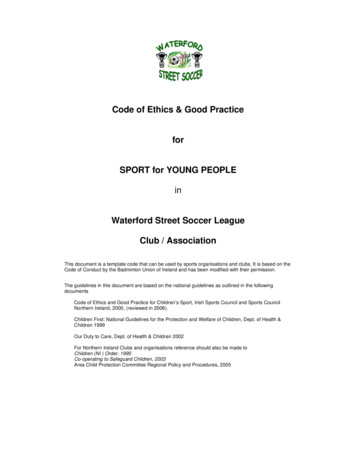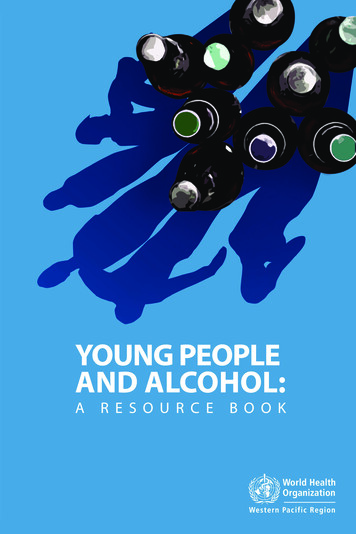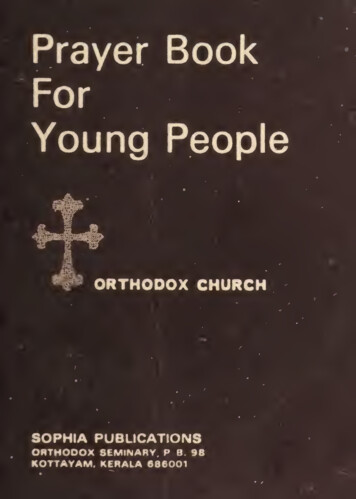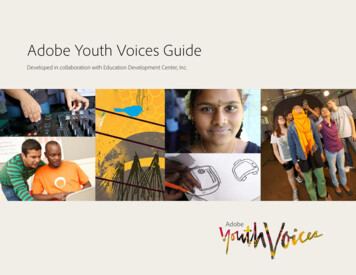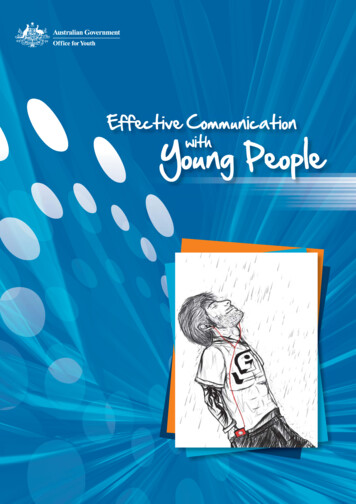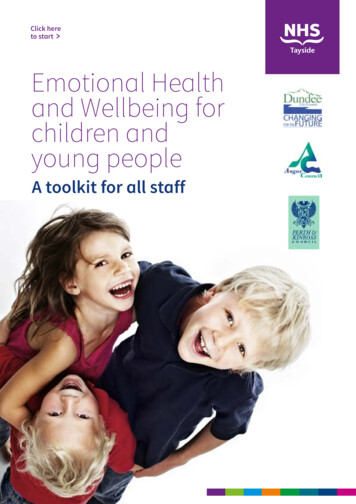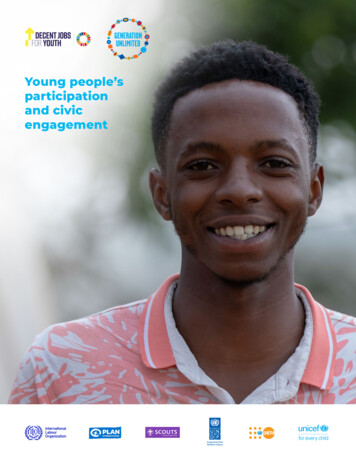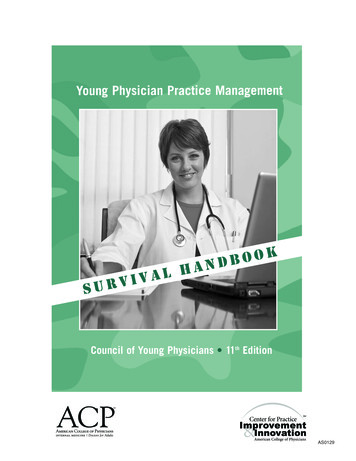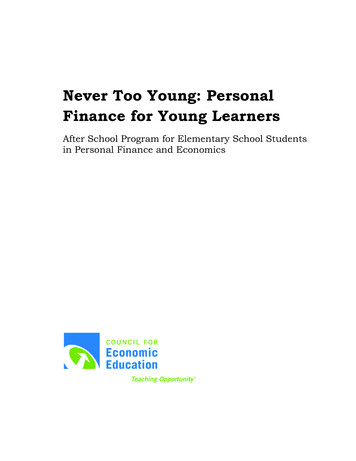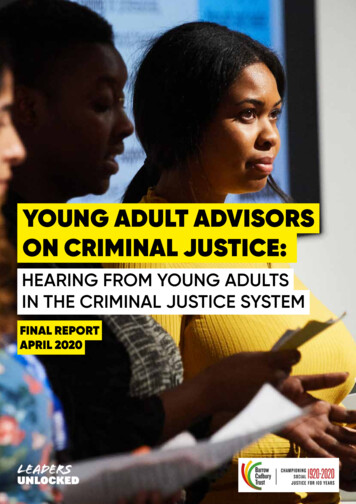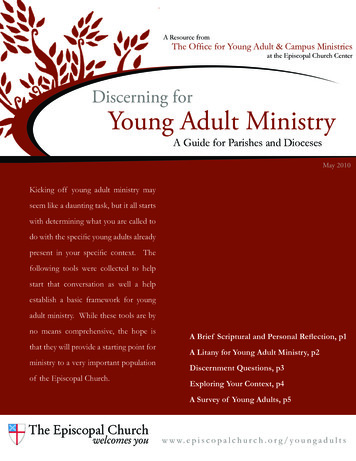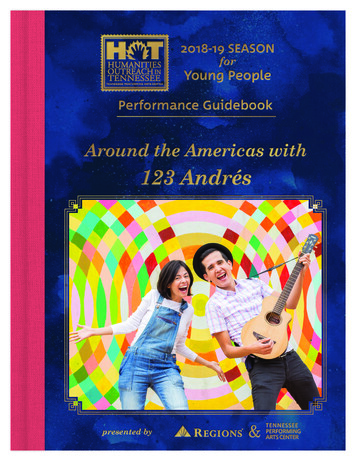
Transcription
2018-19 SEASONforYoung PeoplePerformance GuidebookAround the Americas with123 Andréspresented by&
From our Season SponsorFor 135 years Regions has been proud to be a part of the Middle Tennessee community,growing and thriving as our region has. From the opening of our doors on September 1, 1883,we have committed to this community and our customers.One area that we are strongly committed to is the education of our students. We are proudto sponsor TPAC’s Humanities Outreach in Tennessee (HOT). What an important program thisis – reaching over 30,000 students, many of whom would never get to see a performing artsproduction without this local resource. Regions continues to reinforce its commitment to thecommunities it serves, and in addition to supporting programs such as HOT, we have close to 200associates teaching financial literacy in classrooms this year.Thank you, teachers,for giving your students this wonderful experience. You are creating memories of a lifetime, andRegions is proud to be able to help make this opportunity possible.
Dear Teachers,CONTENTSAround the Americas with 123 Andrés is anincredibly lively and engaging show that willtake your students on a journey through North,Central, and South America using music andstory. Andrés and Christina of 123 Andrés willcaptivate your young listeners, as they move backand forth from Spanish to English in ways thathelp the whole audience to understand theirmeaning and sing with them in both languages.When speaking with these artists, theyexpressed their desire for students to leave theshow practicing more empathy towards others,demonstrating increased geographic literacy,engaging in story, and experiencing a taste of therich musical diversity the Americas offer.About 123 Andréspages 2-3Interview with 123 Andréspages 4-6For that reason, the lessons in this guidebookare geared towards empathy, communication,geography, and storytelling. You will findlessons designed with students from 2nd-4thgrade in mind. The lessons are not sequentialand any combination of lessons is possible.We have included suggestions and ideasfor modifying the lessons with the hope ofanticipating potential road blocks, however, weknow every classroom is unique and you as theteacher are best able to guide the learning. Youwill also find a listening guide and YouTube linkswhere the music of 123 Andrés can be easilyaccessed as well as other musical selectionswhich are highlighted in the lesson plans.We are so excited that you and your studentswill have the opportunity to experience123 Andrés at TPAC with us!Sinceramente,TPAC EDUCATIONListening GuideLesson Uno - Music Connects Uspage 7pages 8-9Lesson Dos Language: Barrier to Bridgepage 10Finger Spelling Chartpage 11Lesson Tres - StorytellingPicture PromptsLesson Cuatro Where in Las Américas?pages 12-13page 14pages 15-16Explore Las Américas Worksheetpage 17Post Exploration-Travel Brochurespage 18Map of the Americaspage 19Recommended Bookspages 20-21Guidebook Writer - Alison BrazilGuidebook Editor - Lattie BrownPhoto credit: Darío Treviño
About 123 Andréspage 2Andrés and Christina are the Latin Grammy-winningmusic duo 123 Andrés, and their award-winning music andlively concerts get the whole audience participating inSpanish and English. 123 Andrés tours nationally with concerts for kids of all ages and their families. They are knownfor bringing joyful sounds, passion for bilingualism and ahigh-energy love of music that encourages kids dancingand singing in Spanish and English.Andrés grew up in Bogotá, Colombia, singing with hismother and learning how to play the guitar from his fatherat an early age. He had his first studio experience at age 8,and from there he went on to earn a Doctorate in Musicand won the National Composition Contest in Colombiafor one of his early songs.Christina grew up in the Midwest in a Spanish-speaking immigrant family from Colombia. Her love for the stage started when her mom signed her up for theater and danceas a child. After college she worked in the classroom as apublic school teacher and received a Masters in Education.When she joined 123 Andrés, she found her calling teaching through music.Andrés and Christina fter the 2016 Latin Grammy ceremonywith their award. Photo Credit Billboard MagazineAndrés and Christina believe in using music as a tool to encourage empathy towards others and pride inone’s own culture. While teaching Spanish words and showcasing different Latin sounds, 123 Andrés alsoaims for children to emerge more accepting, tolerant and curious about people who are different fromthem.Andrés receives a medaland recognition from hisregional government inColumbia.
About 123 Andréspage 3The BandAndrés Salguero from Colombia - guitar, saxophone, vocalsChristina Sanabria from the US – vocals, percussionJesús Agreda from Venezuela - drumsetPablo Sanhueza from Chile - congas, percussionGiovanni Rodríguez from Dominican Republic - bassFuture band members! Andrés and kids exploring instruments Photo credit - Keyla Sanders
Interview with 123 Andréspage 4In creating this performance, what ideas did you want to explore?Andrés:More than anything, we want children to exercise and maintain their empathy. They are naturallywelcoming and open, and they are curious about people who are different rather that afraid of them.As adults then we often lose those qualities. We need to learn from children. The premise of the showoffers a good opportunity to encourage empathy in context. At one point in the show, I am sad becauseI miss my friend, Juana. The children feel for me and want to help. At the end when we finally find Juana,she is a little bit nervous. She’s been lost, and she needs us to be extra kind to her. The children connectwith Juana and respond so beautifully with well-wishes and empathy.The other thing we’d like to encourage is a curiosity about geography. In the busy school day, studentsmight not get a chance to look at a map for a while and take the time to wonder about other countries.That urge to explore is important, and it leads to map literacy and learning that there are so many places inthe world that are not part of the United States, with people living different ways and speaking differentlanguages.We want students of Hispanic origins, Latinx students, to see themselves represented. It is so incrediblewhen you see the kids getting excited and throwing their hands in the air when we are looking at the mapand naming the different countries. When you get to the one they or their parents came from, they feelsuper special and want to talk about it. It’s also great for the other students because they learn abouttheir neighbors and classmates, who come from different places.Christina:I think about newcomers to our school and the situations in which someone might feel unwelcome ordifferent. How we can focus on our similarities with others and build bridges? Certainly, I’m thinkingof those coming from a different country and speaking another language, but also there are plenty ofchildren who feel different due to other factors. How we can go out of our way to be welcoming?How do you feel that music feeds into all these purposes?Christina:Music itself also embraces new and different influences. When we’re performing for older students weget into this more explicitly, but two of the songs we sometimes do, “The Mambo” and “La Bamba”are products of lots of cultural influences. They both have folk origins: for “The Mambo” in Cuba, andfor “La Bamba” in Veracruz, Mexico. Both of these songs crossed over and were blended with elementsof US music. That altered version is the one we recognize most often when we hear them now, on theradio or TV. It’s super interesting because elements of music combine and transform, and we can hearthe folk influences but also hear the rock and roll and jazz elements added later.Andrés:Yes, lots of times what we hear as Latin music is a result of musicians from Latin American cultures gettingtogether in the US and creating something new. It happened that way with Salsa music. Musicians fromCuba and from all over the Caribbean immigrated to the United States, bringing the Mambo with them.
Interview with 123 AndrésAndrés (continued):They all ended up meeting inNew York City mid-twentiethcentury and started playingtogether and with Americanmusicians. They added newelements to the originalmusic, and the style calledSalsa evolved. New York iswhere the term Salsa wascoined, and now Salsa isknown throughout the world.It became a collaborationgenerated by the music,but its result is bigger thanthe music. For example,in the late 50’s at the Palladiumin Manhattan, they held someof the first desegregated dances in New York with Salsa music.There were all kinds of people dancing with each other - very open and very new.page 5Photo credit: Darío TreviñoWhat is the benefit of singing together?Andrés:Singing as a group gets people together doing one thing. It makes us happy and relaxes us. Singing lowersyour heartbeat and can even synchronize the heartbeat of people singing together. Plus, it’s a great wayto promote teamwork. I was reading a study that suggested that students who play or sing music togetherperform better at problem-solving and math and tests because they felt more at ease and in tune witheach other as a group.Not only that, but because music borrows from different places, it can unite us. It’s beautiful how we cantrace the clave rhythm all the way from West Africa. Then we find it in Cuba; we find it in Brazil; we cantrace the DNA of the clave through all its transformations. It becomes a common musical ancestor.Singing helps you learn. The starting lesson is geography and the Americas for every single kid that comesout. If they are asked, “where are the Americas?”, they’ll be able to sing the song and tell you where theAmericas are because we singing that song all together like six times. They do it with their hands! They’regonna remember and understand that people speak Spanish, not only in Mexico, but in all these otherplaces. The music will help with that.The other big lesson they’ll come away with is the importance of empathy and being nice to each other.For me, the music and singing accompany this story and give life to it. The audience gets connected to it.We don’t hammer the lesson in, but the kids naturally want to help poor Juana.
Interview with 123 Andréspage 6How did you get started in music?Andrés:I was very, very privileged and lucky in that therewas music all around me in my home. My momwas always singing, and my dad played the guitar.My mom taught me my first songs, and my dadtaught me how to play my first instrument.Is it hard to move back and forthbetween English and Spanish?Christina:Sometimes it can be hard to move back and forthbetween English and Spanish when you are thinking and moving quickly. It gets easier the more youdo it, but that’s one of the awesome things aboutbeing bilingual. We encourage students to be curious about learning Spanish or sign-language orany other language so they can learn how to communicate in lots of ways to lots of people.Andrés:You know, even when we are babies,Photo credit: Jonathan Edelmanwe make different sounds tuned to our language.Researchers figured out that babies differentiateone kind of speech from another when theyare addressed regularly with different languages. They babble different sounds for each language,and eventually, they recognize that one adult is speaking one language and the other is speakinganother. It’s incredible! As kids, we can learn two languages at the same time.What does having a doctorate in music mean you can do?Andrés: (teasing) You can prescribe music when people are sick!
Listening Guidepage 7The music of 123 Andrés is full of beautifully simple melodies, catchy hooks, exciting Latin American rhythms, Spanish and English, and the potential for rich learning opportunities.When thinking about engaging listeners in music that is not primarily in English, it is important to preparethe listeners for gaining understanding in other ways. Young listeners are particularly open to this idea andwith a little encouragement and preparation will flow easily into understanding. Yes, even if they don’tunderstand Spanish! Letting go of our usual desire to understand all the lyrics in order to understand themusic is a freeing process.The music of 123 Andrés guides the listener by repetition, visual cues, communicative rhythms, and at timesby flowing back and forth from Spanish to English. In songs such as “Los Colores” (The Colors), Andréssings a soothing melody backed with the Caribbean Bachata rhythm, and walks us through learning 4colors names in Spanish- amarillo, verde, azul, and rojo. The context of the colors is given in English andby the end of the song we seamlessly understand that amarillo is yellow, verde is green, azul is blue, androjo is red. A more visceral understanding is gained from songs like “¡Salta, Salta!” (Jump! Jump!). Its highenergy rock en español/reggaetón fusion gives the listener no choice but to jump! “Diez Pajaritos” (TenLittle Birds), although completely in Spanish, is paired with the visual cues in performance and leaves us nodoubt as to the numbers that we are counting, adding, and subtracting.Listening to 123 Andrés OnlineBelow are 3 selections that will be played at the show and are available on YouTube.“¡Salta, Salta!” https://www.youtube.com/watch?v oBiFqDyAZGA“Los Colores” https://www.youtube.com/watch?v GMwSKPH1C Y“Diez Pajaritos” https://www.youtube.com/watch?v sdeOmsivceU123 Andrés Websitetheir albums, listed below.http://www.123andres.com/- Here you will find links to more selections fromAlbums¡Uno, Dos, Tres Andrés!en español y en inglésBest Children’s Album,2015 Latin GRAMMY NomineeArriba AbajoBest Children’s Album,2016 WINNER - Latin GRAMMYLa LunaNew AlbumReleased 2018
Lesson Uno - Music Connects UsLearning Goals: Learners effectively connect andcommunicate in various ways, including through bodylanguage and music.Skills:Empathy, Problem Solving, Communicating,Comparing/Contrasting, Connectingpage 8CCSS.ELA CCSS.ELA-LITERACY.CCRA.SL.1Prepare for and participate effectively ina range of conversations and collaborations with diverse partners, building onothers’ ideas and expressing their ownclearly and persuasively.Essential Questions:How can you connect to someone who doesnot speak the same language as you?How is body language an effective modeof communication?How does music communicate a feeling?Enduring Understandings:Materials:Technology to play the suggested songs playlistSpeakersIntro (10 min):Photo credit: Jose Eduardo LeonWe may use different words, but we canstill understand the same emotional message.We can transmit our feelings to others withbody language.We may have different ways of saying it,but we have the same things to say.Music is a universal language. We can feel it.Teacher plays several musical selections of contrasting types of music. In an open space, students areencouraged to dance, move, and interpret the song. This should be done with everyone at the same timeand students should move individually, avoiding physical contact with other students. They are “individually dancing in a group”.After 30-45 seconds of each selection, teacher pauses the music, freezes students with a signal, and asksa few questions such as, Does the music make you feel any particular way? How did you want to move, listening to this music? Did everybody in your class dance the same way for each song?This should be a quick whole class analysis with answers such as “Happy! I moved fast!” After listeningand moving to each song, have students formulate conclusions as to whether and how music helpedthem connect to each other. Students discuss with shoulder partner to think of scenarios in which musiccan help people who don’t know each other connect and communicate.
Lesson Uno - Music Connects Uspage 9Suggested Songs: This list offers examples of musical styles and genres that represent many areasof Latinoamérica that will encourage varied types of movement.1. “Vivir Mi Vida”- Marc Antony https://www.youtube.com/watch?v alUhI7WUnh42. “Stand By Me”- Stand By Me https://www.youtube.com/watch?v UqWexqEIn683. “Mi Gente”- J. Balvin, Willy William- https://www.youtube.com/watch?v sJgjKUK5 VA4. “Oye Mi Amor- Maná” https://www.youtube.com/watch?v DcnNeGQHwDc5. “La Pollera Colorá”- Wilson Choperena y Juan Madera https://www.youtube.com/watch?v 289Gie5B4rg6. “Drume Negrita”- Mercedes Sosa https://www.youtube.com/watch?v -ne0zL4LSFMAsk students in groups of three to devise different shortplaylists, using music to communicate in three different ways.Suggestion: Make sure students know that they do nothave to create these lists with actual devices in class. Also,they do not have to have the full song title or artist’s name.A bit of lyric or description is fine, especially if they can singa bit of it, or tell you about where they heard it, for example:“‘sunshine in my pocket’ from the Trolls movie” (Can’t Stopthe Feeling!” by Justin Timberlake) or “that firework song”(“Firework” by Katie Perry).Photo credit: Darío TreviñoLesson (15 min):1. For Playlist #1, choose songs that are expressive, that willshow a class visitor something about the spirit of the class.2. For Playlist #2, choose songs that capture a mood, one thestudents would like a visitor to feel.3. For Playlist #3, choose songs that are representative andinclude a favorite song of each of the members of thegroup. Depending on time, each group can work on all theplaylists or just one.4. Ask a few groups to share their list representing the spirit of the class.5. Post the lists in the classroom.Reflection (10 minutes): Discuss with students that just like there are different kinds of people,there are different kinds of music. Sometimes being open to music from different cultures and differenttime periods can be another way to make connections with people that students don’t know. What different types of music have students encountered? Do students know more music from other countries?Extensions:1. Teachers share with students a short playlist of their own, with less contemporary music or musicalstyles unfamiliar to the students, that captures how the teacher sees the spirit of the class. This musiccan perhaps be played during a class transition.2. Challenge students to find out a few musical favorites of a parent or other older relative. Ask them toalso find out the story of where the adult first heard it, and why they liked it.
Lesson Dos Language: Barrier to Bridgepage 10Learning Goals: Exploring what it feels like to speak a language no one understandsMaterials: Copies of Finger Spelling HandoutFinger Spelling Poster (optional)Essential Questions:How does sign language help others communicate?Are there messages that everyone in the worldcommunicates the same way?CCSS.ELA CCSS.ELA-LITERACY.CCRA.SL.1Prepare for and participate effectively ina range of conversations and collaborations with diverse partners, building onothers’ ideas and expressing their ownclearly and persuasively.Warm-up (5 min): Music is a language accessible to almost everyone. Sign language helps communicate without using sounds. Demonstrate a few words, phrases, or expressions in sign language.Lesson (30 min): Imagine traveling to a world with no sound.this world for a little while and really want to make friends there.Explain that the class will be staying inSuggestion: As facilitator, narrate and dramatize this ‘world’ during the instructions as much as possible, stressing that this is a silent world. After giving initial instructions, really work to conduct the activitycompletely using non-verbal communication, but if verbal instructions are needed, make them concise.Examples: Smile, wave Hello, cry, laugh, point, frown, use our hands to motion or animate, act it out, etc.This activity will work best as a quiet activity. Students will have many giggles and bodily function noisesto get out at the beginning. Work to ignore and let time normalize the silence. There will be moments offrustration but strive to push through for the bigger lightbulb moments at the end.1. Teacher gives last verbal instructions, “As you arrive in this new world, it is your goal to communicatewith everyone in the room that you are happy to be their friend. To do that, you will need to meet, greet,and communicate friendliness to each person in the room.” On signal, students begin activity.2. Give signal for students to circle. Non-verbally congratulate all students on their friendliness.3. Non-verbally communicate to students that the next step is to find out each new friend’s name in thenew world. Distribute the handout* of the sign language alphabet. Consider having a poster size signlanguage alphabet for students in addition to the personal handouts. Model the process of finger spelling one’s name. Consider using a student to model. Give signal for students to begin to amble around theroom asking for 2 or 3 of their new friends to sign their names.4. Give signal for students to circle. Non-verbally ask for 2 or 3 student volunteers to sign their names.Non-verbally congratulate them. Perhaps using finger spelling.Reflection (10 min): Move students from silent world to hearing world once more using a physicalchange of space if possible or a sounding signal to break the silence before speaking. Thank students nonverbally and verbally for journeying with you to the world with no sound.Consider having students transition to a guided journal writing reflection, in keeping with the quiet theme.Guide them in answering: Did you feel frustrated? Why? What can the silent world help us learn aboutother people? What did we learn about ourselves? What did we learn about communicating? Do we needa specific language to communicate with others? Can we only make friends with people that speak like us?
Lesson Dos - Finger Spellingpage 11*Handout is an American Sign Language resource from Education.com.American Sign LanguageFinger Spelling ChartAeimquYAeimqubfjnrvzbfjnrvcgkoswcdhlptxdg hk loswptxyzCopyright 2010-2011 by Education.comMore worksheets at www.education.com/worksheets
Lesson Tres - StorytellingLearning Goals: Learners narrate a creative andorganized story successfully implementing elementsof story and storytelling.Skills:page 12CCSS.ELA LITERACY.W.3.3Write narratives to develop real or imagined experiences or events using effectivetechnique, descriptive details, and clearevent sequences.Listening, Speaking, Creativity, CollaborationEssential Questions:What characteristics do stories share?What makes a story “good”?What makes a storyteller “good”?Can music play a part in storytelling?Enduring Understandings:Stories have a beginning, middle, and ending that involves characters, a setting, and a problemthe characters face.Good storytellers know how to speak clearly, use inflection in their voices, and use non-verbalcommunication as well to engage their audience.Materials:Picture Prompts (page 14) for a main character, a setting, and something to include in the story. **Large map of The Americas (as a reference)**Before this lesson, prep picture prompts to use in a teacher demonstration. You will also need a problemfor the characters to solve and possibly a way to include a song in the solution. Consider coming up withpossible storylines ahead of time in order to make that much more of an engaging story during the lesson.Intro (5 min):Ask students to recall what they know about the characteristics of a storyand characteristics of a storyteller.Hook (10 min) : Have 3 different students choose one picture prompt from the various categories.Show the students each picture prompt (character, setting, and object) and let them know that you aregoing to invent a story right now using the 3 prompts.Tell a very short but engaging story using your best storytelling tricks. Include snippets of a song in the solution if you feel comfortable. Use inflection in your voice, facial expressions, hand motions, and even referto the picture prompts as visual aids when necessary.Reflection (5 min): Ask students to take turns retelling the story to their shoulder partner.Givesignal for students to direct their attention to you again and ask, “What did you remember most about thestory? Why? What characteristics did the story have? What characteristics did the storyteller demonstrate?
About 123 Andréspage 13Lesson (30 min): Today we are going to practice our story making and storytelling skills.We aregoing to use the picture prompts to first guide us in creating the story map. Our story will have a maincharacter; we will describe the setting; and our character will encounter a problem. The story will havea beginning, middle, and end.Suggestion:1.2.3.4.Have a signal that allows for smooth and clear transitions between steps of lesson.Have students pair up and together choose one of each picture prompts, 3 total. At this time studentswill brainstorm story ideas, character names, and possible problem solutions, etc. with each other.Students should now share their brainstorm ideas with the student pair group beside them.Students revise their ideas and continue to cement their story. Students practice telling the story.Guide student pair groups in a checklist of their story. Ask if their story has a main character, setting,problem, solution, clear ending, etc. Have students use hand signals to communicate with you yes, no,not sure.Whole Group Reflection (10 min):Connect students with another pair to share their stories.What are the characteristics of a good story and storyteller?Partner Reflection (10 min):Have students answer the following questions in written form orin the form of shoulder partner guided discussion, about both their own stories and the stories they heardfrom another pair of students. What elements of story did you and your partner’s story have? What elements of storytelling did you and your partner demonstrate? What was exciting about the story you heard from a different pair? How did you come up with a problem? How did youPhoto credit: Sabine Westsolve it? Were you able toinclude a song inthe solution?
Lesson Tres - Picture Promptspage 14CharactersLA LLAMAEL GECOEL PAJARITOPlacesCENTROAMÉRICALA CASAEL CARIBESURAMÉRICAObjectsDINEROLOS LENTES
Lesson Cuatro-page 15WHERE IN LAS AMÉRICAS?Learning Goals: Students will develop map literacy andpractice deductive reasoning using previous knowledge.Skills: Critical Thinking, Map Literacy, CollaborationCCSS.ELA LITERACY.RI.3.7Use information gained from illustrations(e.g., maps, photographs) and the wordsin a text to demonstrate understanding ofthe text (e.g., where, when, why, and howkey events occur).Essential Questions:What are the Americas? How can a map help us to answer questions about the Americas?Enduring Understandings:Sometimes we call The United States of America just ‘America’, but the Americas include all of North, Central, and South America.Maps have several tools to help use make educated guesses about climate, transportation, topography,and even culture.Materials:Class Map of Western Hemisphere (digital, pull-down map, globe, poster, etc)CompassCopies of the Explore Las Américas worksheet on page 17 and the map of the Americas handout on page 19Classroom technology to investigate countries (optional)Intro (10 min):Ask students to define ‘America’. Now, define ‘The Americas’. Now, look at the class map of the WesternHemisphere and hone definition of ‘The Americas’. Facilitate the understanding of North America,Central America, the Caribbean, and South America. Ask students to compare and contrast bothmeanings of America.Hook (5 min): Have a show and tell moment with a compass.Allow students to experience thecompass. Facilitate a conversation about previous knowledge regarding the 4 cardinal directions. Directthe inquiry towards understanding of cold weather closer to the north and south poles, warmer climatenear center, sun rising in the east, setting in the west, etc.Lesson (30 min): Guide students through identifying their previous knowledge.(Where is the UnitedStates, Tennessee, North and South Pole, etc. We can travel from TN to Mexico by land but not by sea. Wecannot travel to the Caribbean by land, etc.)Suggestion: Have several class sets of maps, globes, and even Google maps available for students touse as a reference.1. In pairs, students choose or are assigned a country either in Centroamérica, El Caribe, or Suramérica.They can color their country on the map of Americas outline handout on page 19. Encourage them touse the class map to make as many educated guesses about that country as possible. Students arebrainstorming mode of transportation, climate, clothing preferences, local food, etc.
Lesson Cuatro-page 16WHERE IN LAS AMÉRICAS?2. Walk through an example of map inquiry and observation with the students, modeling your critical thinking and hypothesizing out loud. Consider showing this process with Mexico even thoughit is not in Central America, South America, or the Caribbean. Students are more likely to havebackground knowledge about Mexico and would feel more confident about hypothesizing aboutMexico’s climate, modes of transportation, etc. Modeling will also establish the vocabulary desiredfor this activity. Consider taking the time to invest in the scientific method vocabulary, especiallyfacilitating an understanding of hypothesis and the value of making educated guesses.3. Have students fill out the worksheet on page 17 with their predictions.4. Pair/Share (5 min): Students share with the pair next to them. Use a signal to indicate when first groupbegins and ends, in order for second group to begin.5. Students individually, where possible, use classroom technology to research their country. Considermodeling the query process on classr
pages 2-3 pages 4-6 page 7 pages 8-9 page 10 page 11 pages 12-13 page 14 pages 15-16 page 17 page 18 page 19 pages 20-21 Guidebook Writer - Alison Brazil Guidebook Editor - Lattie Brown Dear Teachers, Around the Americas with 123 Andrés is an incredibly lively and engaging show that will take your students on a journey through North,
